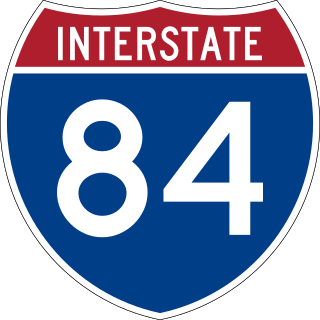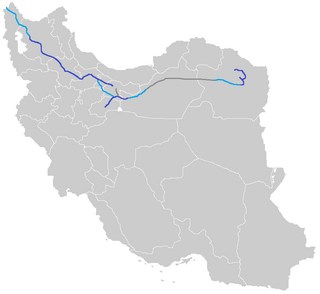
The Dwight D. Eisenhower National System of Interstate and Defense Highways, commonly known as the Interstate Highway System, or the Eisenhower Interstate System, is a network of controlled-access highways that forms part of the National Highway System in the United States. The system extends throughout the contiguous United States and has routes in Hawaii, Alaska, and Puerto Rico.

Highways in Australia are generally high capacity roads managed by state and territory government agencies, though Australia's federal government contributes funding for important links between capital cities and major regional centres. Prior to European settlement, the earliest needs for trade and travel were met by narrow bush tracks, used by tribes of Indigenous Australians. The formal construction of roads began in 1788, after the founding of the colony of New South Wales, and a network of three major roads across the colony emerged by the 1820s. Similar road networks were established in the other colonies of Australia. Road construction programs in the early 19th century were generally underfunded, as they were dependent on government budgets, loans, and tolls; while there was a huge increase in road usage, due to the Australian gold rushes. Local government authorities, often known as Road Boards, were therefore established to be primarily responsible for funding and undertaking road construction and maintenance. The early 1900s saw both the increasingly widespread use of motorised transportation, and the creation of state road authorities in each state, between 1913 and 1926. These authorities managed each state's road network, with the main arterial roads controlled and maintained by the state, and other roads remaining the responsibility of local governments. The federal government became involved in road funding in the 1920s, distributing funding to the states. The depression of the 1930s slowed the funding and development of the major road network until the onset on World War II. Supply roads leading to the north of the country were considered vital, resulting in the construction of Barkly, Stuart, and Eyre Highways.
A routenumber, designation or abbreviation is an identifying numeric designation assigned by a highway authority to a particular stretch of roadway to distinguish it from other routes and, in many cases, also to indicate its classification, general geographical location and/or orientation. The numbers chosen may be used solely for internal administrative purposes; however, in most cases they are also displayed on roadside signage and indicated on maps.

A county highway is a road in the United States and in the Canadian province of Ontario that is designated and/or maintained by the county highway department. Route numbering can be determined by each county alone, by mutual agreement among counties, or by a statewide pattern.

The state highway system of the U.S. state of Oregon is a network of highways that are owned and maintained by the Highway Division of the Oregon Department of Transportation (ODOT).

A controlled-access highway is a type of highway that has been designed for high-speed vehicular traffic, with all traffic flow—ingress and egress—regulated. Common English terms are freeway, motorway and expressway. Other similar terms include throughway and parkway. Some of these may be limited-access highways, although this term can also refer to a class of highways with somewhat less isolation from other traffic.
In New York, a reference marker is a small green sign mounted approximately every one-tenth mile on highways maintained by the New York State Department of Transportation. This was initiated in response to the Highway Safety Act of 1966 enacted by Congress, in an effort to monitor traffic and identify high-accident locations. New York's system inventories and indexes all touring and reference routes, in addition to service and rest areas, ramps, and reservation roads.

Road 65 is an important transit road connecting Tehran to Fars in Iran.

Freeway 7 is a freeway in central Iran. It starts from Jahad Square at the south end of Kazemi Expressway and Azadegan Expressway in Tehran. It then passes Behesht-e Zahra, Imam Khomeini Int'l, Qom, Kashan, Natanz, Shahinshahr, Najafabad and currently ends at the northeast of Zarrinshahr in a junction with Road 51 and Zobahan Freeway. However, there has been construction after the junction and so far, 7 kilometres (4.3 mi) has been completed. In recent years, construction has been made in order to connect this freeway to Shiraz under the name Esfahan-Shiraz Freeway, which starts from Izadkhast and currently ends at the northwest of Shiraz in a junction with Road 67, and it is planned to end in Hosseini Al-Hashemi Expressway. It was opened in Mehr 1402. The Freeway from Isfahan to Izadkhast is currently planned, but yet to start construction. There are also plans to connect the freeway to Bushehr.

Freeway 2 in Iran consists of two separate sections, one in northwestern Iran and one in northeastern Iran.
Road 56 is a road in central Iran. It connects the central city of Qom in Qom province to western city of Borujerd in Lorestan province. It starts from the northern Ring road of Qom then connects Qom - and via other roads Tehran and Esfahan - to the industrial city of Arak. After Arak it continues towards west and it ends in Borujerd there run into by Road 37 & Road 52.
This article describes the highway systems available in selected countries.
Asian Highway 72 (AH72) is a road in the Asian Highway Network running 1042 km from Tehran to Bushehr, Iran. The route is as follows:
The 2013–14 Iranian Futsal Hazfi Cup were the 1st season of the Iranian futsal knockout competition. Mahan Tandis Qom won the title with defeating Misagh Tehran in the final.

The Delaware State Route System consists of roads in the U.S. state of Delaware that are maintained by the Delaware Department of Transportation (DelDOT). The system includes the portions of the Interstate Highway System and United States Numbered Highways system located in the state along with state routes and other roads maintained by DelDOT. All roads maintained by the state are assigned a maintenance road number that is only marked on little white markers at intersections and on auxiliary plates below warning signs approaching intersections. These numbers are only unique in a specific county; some roads can be designated with multiple road numbers, and numbers do not necessarily correspond to the signed Interstate, U.S., or state route numbers. DelDOT maintains a total of 5,386.14 miles (8,668.15 km) of roads, comprising 89 percent of the roads within the state. Some large bridges in the state are maintained by other agencies including the U.S. Army Corps of Engineers and the Delaware River and Bay Authority. Roads in the system include multilane freeways, multilane surface divided highways, and two-lane undivided roads serving urban, suburban, and rural areas. Some of the roads maintained by DelDOT are toll roads, in which motorists must pay to use.
The 2015–16 Hazfi Cup was the 29th season of the Iranian football knockout competition. Zob Ahan Isfahan was the defending champion. The competition started on 27 August 2015 and the final was played on 29 May 2016.
Zob Ahan won the tournament for the second time in a row after defeating Esteghlal in the final.

Tehran–Qom–Isfahan high-speed rail is the first truly high-speed rail project in Iran. Construction began on 25 February 2015. The rail line would decrease travel times between Tehran and Isfahan, passing through Qom. It connects Isfahan and Qom to Imam Khomeini International Airport.












